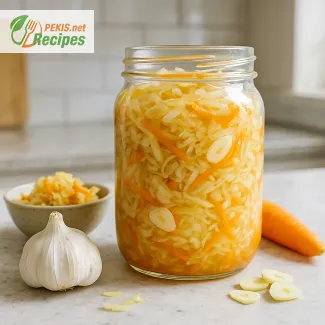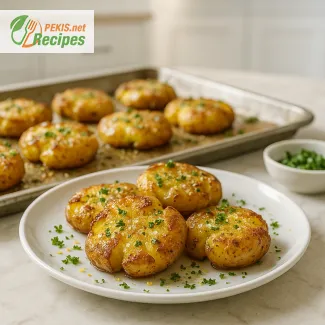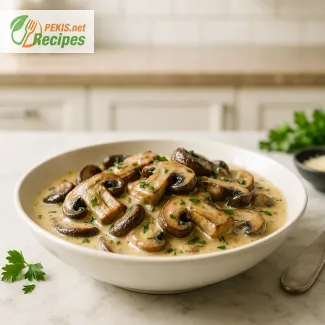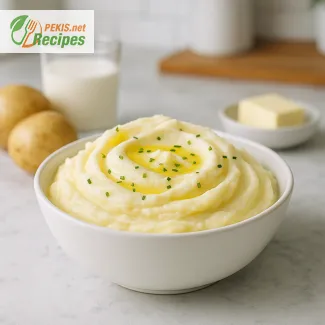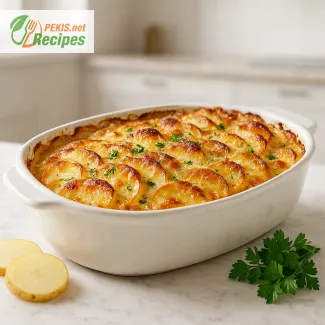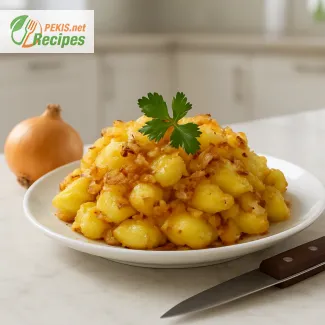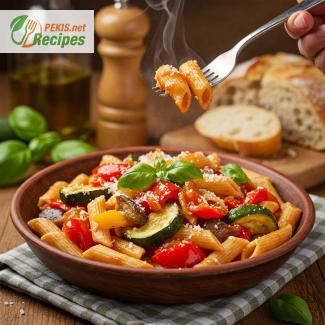
A Delightful Twist on Classic Ratatouille with Pasta
A Mediterranean-Inspired Dish Full of Flavor
If you love hearty, vegetable-packed meals with a burst of Mediterranean flavors, this easy Ratatouille Pasta recipe is a must-try. Combining the rustic charm of traditional ratatouille with the comforting appeal of pasta, this dish is a perfect balance of fresh ingredients, vibrant colors, and rich flavors. With its tender roasted vegetables, aromatic herbs, and a luscious tomato-based sauce, every bite delivers the essence of Provençal cuisine. Whether you're looking for a healthy weeknight dinner, a meatless meal bursting with nutrients, or a way to make the most of seasonal vegetables, this dish will not disappoint.
The Origins of Ratatouille: A French Classic with a Twist
Ratatouille hails from the sun-soaked region of Provence, France, where it has been a staple of home cooking for generations. Traditionally, it is a slow-cooked vegetable stew made with zucchini, eggplant, bell peppers, tomatoes, garlic, and aromatic herbs. This dish is not only a celebration of simple, high-quality ingredients but also a testament to Mediterranean culinary traditions that emphasize fresh produce and natural flavors.
By pairing ratatouille with pasta, we create a dish that is both comforting and sophisticated, offering a new way to enjoy these classic Provençal flavors. The sauce, rich with slow-simmered vegetables and fragrant herbs, coats the pasta beautifully, making it an ideal choice for family meals, dinner parties, or meal prepping for the week ahead.
Why You’ll Love This Ratatouille Pasta
A Nutrient-Packed, Wholesome Meal
One of the highlights of this ratatouille-inspired pasta is its abundance of vitamins, minerals, and antioxidants. Packed with fiber-rich vegetables and a variety of essential nutrients, this dish is not only delicious but also incredibly nourishing. The combination of eggplant, zucchini, bell peppers, and tomatoes provides a mix of vitamin C, potassium, and powerful antioxidants that support overall well-being.
For those following a vegetarian or vegan diet, this recipe is a perfect choice. It delivers a satisfying, umami-rich depth of flavor without the need for meat, making it an excellent option for Meatless Mondays or plant-based meal planning. Additionally, the use of olive oil and garlic brings out the best in these vegetables, enhancing their natural sweetness and richness.
A Versatile and Customizable Dish
Another reason to love this ratatouille pasta is its versatility. It pairs beautifully with a variety of pasta types, from classic spaghetti and penne to whole wheat or gluten-free alternatives. If you're looking for a lighter option, you can even swap traditional pasta for zoodles (zucchini noodles), chickpea pasta, or lentil-based pasta.
For an added protein boost, consider topping it with grated Parmesan, crumbled feta, or a dollop of creamy ricotta. If you prefer a heartier meal, you can serve it alongside grilled chicken, shrimp, or even a plant-based protein like tofu or chickpeas. The possibilities are endless, making it easy to tailor this dish to your personal preferences.
Cooking Techniques That Enhance Flavor
Slow Roasting for Depth of Taste
To achieve the richest flavor profile, slow roasting the vegetables before combining them with the sauce is a game-changer. Roasting helps caramelize the natural sugars in eggplant, zucchini, and peppers, intensifying their sweetness and depth. The result is a more robust, deeply flavored sauce that pairs beautifully with pasta.
The Importance of Fresh Herbs and Spices
Herbs play a crucial role in elevating the flavors of ratatouille pasta. A blend of fresh basil, oregano, thyme, and rosemary adds a fragrant, Mediterranean touch that ties the dish together. For an extra layer of warmth, a pinch of red pepper flakes or smoked paprika can enhance the dish’s complexity without overpowering the natural vegetable flavors.
The Perfect Sauce Consistency
Balancing the texture of the sauce is key to creating a harmonious pasta dish. A combination of crushed tomatoes, olive oil, and slow-cooked vegetables ensures a silky, flavorful coating that clings to every strand of pasta. If you prefer a richer, velvety consistency, adding a splash of vegetable broth or a touch of tomato paste can enhance the depth of the sauce.
Serving Suggestions and Pairing Ideas
Ratatouille pasta is a standalone masterpiece, but it pairs wonderfully with a variety of side dishes and accompaniments. Consider serving it with:
- A crusty baguette or garlic bread to soak up the delicious sauce
- A fresh green salad with a light vinaigrette to add a refreshing contrast
- A glass of dry white wine, such as Sauvignon Blanc or Chardonnay, to complement the Mediterranean flavors
- A sprinkle of toasted pine nuts or walnuts for an added crunch and nutty undertone
Bringing a Taste of Provence to Your Table
This easy Ratatouille Pasta recipe is more than just a meal—it’s a culinary journey that brings the best of French and Italian traditions together on one plate. Whether you're preparing it for a cozy dinner at home or impressing guests with a vibrant and wholesome dish, this recipe is sure to become a favorite in your repertoire.
With its rich, aromatic flavors and endless possibilities for customization, this dish proves that simple ingredients, when prepared with care, can create something truly extraordinary. So grab your favorite pasta, gather the freshest vegetables, and enjoy a homemade meal that celebrates the beauty of Mediterranean cuisine.
- Prepare the Vegetables:
- Preheat the oven to 200°C (400°F).
- Place the diced eggplant, zucchini, red and yellow bell peppers on a baking sheet. Drizzle with 1 tablespoon of olive oil, and sprinkle with salt and black pepper. Toss to coat evenly.
- Roast the vegetables in the preheated oven for 25 minutes, stirring halfway through, until they are tender and slightly caramelized.
- Cook the Pasta:
- While the vegetables are roasting, bring a large pot of salted water to a boil.
- Add the pasta and cook according to the package instructions until al dente.
- Reserve 1/2 cup (120 ml) of the pasta cooking water, then drain the pasta and set aside.
- Prepare the Sauce:
- In a large skillet, heat the remaining 1 tablespoon of olive oil over medium heat.
- Add the diced onion and sauté for 3-4 minutes until translucent.
- Stir in the minced garlic, dried thyme, dried oregano, and red pepper flakes (if using). Cook for an additional minute until fragrant.
- Pour in the canned diced tomatoes, including their juices. Bring the mixture to a simmer and let it cook for 10 minutes, allowing the flavors to meld.
- Combine All Components:
- Add the roasted vegetables to the tomato sauce, stirring to combine.
- Gently fold in the cooked pasta, ensuring it is well-coated with the sauce. If the mixture seems dry, add some of the reserved pasta cooking water, a little at a time, until the desired consistency is reached.
- Season with additional salt and black pepper to taste.
- Serve:
- Divide the ratatouille pasta into serving bowls.
- Garnish with chopped fresh basil leaves and a sprinkle of grated Parmesan cheese, if desired.
- Serve immediately.
Elevating Ratatouille Pasta: Enhancing Flavor and Texture
Small Changes That Make a Big Difference
Ratatouille Pasta is already a flavorful and wholesome dish, but there are several ways to enhance its taste, texture, and nutritional value. By adjusting ingredients, cooking methods, and seasoning, you can create a dish that is richer, healthier, or more indulgent, depending on your preferences. Here’s how you can elevate this classic Mediterranean-inspired pasta dish.
Choosing the Best Ingredients for Maximum Flavor
Opting for High-Quality Tomatoes
Tomatoes are the heart of the sauce, so choosing the right variety makes a significant impact on the overall taste. Instead of canned diced tomatoes, try using San Marzano tomatoes, which are sweeter, less acidic, and naturally richer in flavor. Roasting fresh cherry tomatoes before blending them into the sauce also enhances their natural sweetness and adds a slightly smoky depth.
Using Fresh Herbs Instead of Dried
While dried thyme, oregano, and basil are common in traditional ratatouille, fresh herbs provide a much more vibrant and aromatic experience. Adding fresh basil and thyme at the end of cooking helps preserve their delicate flavors, while a small amount of fresh rosemary can introduce an earthy undertone.
Selecting the Right Pasta
The choice of pasta type affects how well the sauce clings to it. Penne, fusilli, and rigatoni work exceptionally well as they have ridges or a spiral shape that captures the sauce, ensuring each bite is full of flavor. For a lighter alternative, try whole wheat, chickpea, or lentil-based pasta, which not only provide more fiber and protein but also add a slightly nutty flavor that complements the dish.
Cooking Techniques That Enhance the Dish
Roasting vs. Sautéing the Vegetables
While sautéing the vegetables is traditional, roasting them at a high temperature intensifies their natural flavors. Eggplant, zucchini, and bell peppers develop a slight caramelization, adding a rich, smoky sweetness that deepens the dish’s complexity.
For the best results:
- Preheat the oven to 200°C (400°F).
- Toss the chopped vegetables in a little olive oil, salt, and pepper.
- Spread them out on a baking sheet in a single layer and roast for 20–25 minutes until lightly charred.
Roasting also reduces the bitterness of eggplant, making it smoother and more enjoyable.
Enhancing the Sauce with Slow Simmering
Instead of quickly cooking the tomato sauce, simmering it for 30–40 minutes allows the flavors to develop fully. Adding a splash of red wine can deepen the sauce, while a teaspoon of balsamic vinegar balances the acidity and enhances the sweetness of the tomatoes.
For a creamier texture, consider blending half of the sauce while leaving the other half chunky, creating a silky yet rustic consistency.
Avoiding Common Mistakes
Overcooking the Vegetables
One of the most frequent mistakes is overcooking the vegetables until they become mushy. Each vegetable should retain some texture to prevent the dish from turning into an overly soft mixture. By cooking the vegetables separately and combining them just before serving, you ensure they maintain their structure.
Using Too Much Olive Oil
While olive oil adds richness, using too much can make the dish feel heavy. A balanced approach is to use just enough for roasting and sautéing, then drizzle a small amount at the end for a fresh, fruity finish.
Overcrowding the Pan
When sautéing vegetables, overcrowding the pan prevents proper caramelization and results in steamed vegetables rather than flavorful, browned pieces. Cooking in small batches ensures each vegetable gets the perfect texture and color.
Healthier Alternatives Without Compromising Taste
Reducing Sodium and Fat Content
To make the dish healthier, opt for low-sodium canned tomatoes and limit the amount of added salt. Instead, enhance flavor with garlic, fresh herbs, and a squeeze of lemon juice.
For a lower-fat version, use vegetable broth instead of extra olive oil when sautéing onions and garlic. This maintains moisture while keeping the dish light and healthy.
Making It Gluten-Free
To make gluten-free Ratatouille Pasta, simply swap regular pasta for gluten-free options like quinoa pasta, brown rice pasta, or chickpea pasta. These alternatives provide extra nutrients while keeping the dish suitable for those with gluten sensitivities.
Boosting Protein Content
For a protein-packed meal, consider adding:
- Grilled chicken or shrimp for a lean protein boost.
- Chickpeas or white beans for a plant-based alternative.
- Tofu or tempeh, marinated and lightly seared for added texture.
Sprinkling nutritional yeast instead of Parmesan also provides a cheesy, umami flavor while increasing vitamin B12 intake for plant-based eaters.
Why Homemade Ratatouille Pasta Is Always Better
Control Over Ingredients
Making ratatouille pasta from scratch allows you to choose the freshest ingredients and adjust seasonings to your taste. Store-bought sauces often contain preservatives, excess sugar, and artificial flavors, which can dull the natural vibrancy of the dish.
Cost-Effective and Sustainable
Preparing this dish at home is more affordable and helps reduce food waste by utilizing seasonal vegetables. Plus, homemade pasta dishes tend to have less packaging waste, making them a more sustainable choice.
Customization to Fit Dietary Needs
A homemade version ensures you can tailor the dish to meet specific dietary requirements, such as low-carb, dairy-free, or high-protein variations. You also have the freedom to adjust spice levels and experiment with different vegetables to keep the dish exciting.
Enhancing Ratatouille Pasta is all about thoughtful ingredient selection, careful preparation, and slight modifications to suit your personal taste and dietary preferences. By roasting vegetables, using fresh herbs, selecting high-quality pasta, and balancing the flavors of the sauce, you can elevate this classic dish into something extraordinary.
Whether you prefer a richer, creamier version, a lighter, healthier take, or an extra protein boost, these small adjustments can make a significant impact on the taste, texture, and overall enjoyment of the dish. So next time you prepare Ratatouille Pasta, try implementing these tips and enjoy a meal that’s even more delicious and satisfying!
- Gluten: This recipe contains gluten due to the pasta. To make it gluten-free, substitute with gluten-free pasta varieties.
- Dairy (Parmesan Cheese): Parmesan cheese is optional. For a dairy-free version, omit the cheese or use a dairy-free alternative.
- Vitamin A: 800 IU (16% DV) – Supports vision and immune function.
- Vitamin C: 60 mg (80% DV) – Antioxidant that aids in tissue repair and immune health.
- Calcium: 100 mg (10% DV) – Essential for bone health.
- Iron: 3 mg (17% DV) – Crucial for oxygen transport in the blood.
- Potassium: 900 mg (26% DV) – Helps maintain normal blood pressure.
Lycopene: Approximately 6 mg – Found in tomatoes; may reduce the risk of certain chronic diseases.
